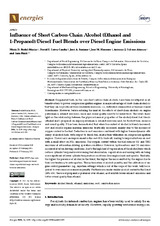Mostrar el registro sencillo del ítem
Influence of Short Carbon-Chain Alcohol (Ethanol and 1-Propanol)/Diesel Fuel Blends over Diesel Engine Emissions
| dc.contributor.author | Redel-Macías, María Dolores | |
| dc.contributor.author | Leiva-Candia, David Eduardo | |
| dc.contributor.author | Soriano, José A. | |
| dc.contributor.author | Herreros, José M. | |
| dc.contributor.author | Cubero-Atienza, Antonio J. | |
| dc.contributor.author | Pinzi, Sara | |
| dc.date.accessioned | 2021-03-02T09:22:06Z | |
| dc.date.available | 2021-03-02T09:22:06Z | |
| dc.date.issued | 2021 | |
| dc.identifier.uri | http://hdl.handle.net/10396/21104 | |
| dc.description.abstract | Oxygenated fuels, in this case short carbon-chain alcohols, have been investigated as alternative fuels to power compression ignition engines. A major advantage of short-chain alcohols is that they can be produced from renewable resources, i.e., cultivated commodities or biomass-based biorefineries. However, before entering the market, the effects of short-chain alcohols on engine performance, exhaust emissions, noise and sound quality need to be understood. This work sheds light on the relationship between the physicochemical properties of the alcohol/diesel fuel blends (ethanol and 1-propanol) on engine performance, exhaust emissions and, for the first time, on noise and sound quality. It has been demonstrated that when the content of alcohol in blends increased, soot and soluble organic material emissions drastically decreased, mainly due to the increase of oxygen content in the fuel. Reduction in soot emissions combined with higher thermodynamic efficiency of alcohol fuels, with respect to diesel fuel, enable their utilization on compression ignition engines. There is also an improvement in the soot-NOx trade off, leading to large reductions on soot with a small effect on NOx emissions. The oxygen content within the fuel reduces CO and THC emissions at extra-urban driving operation conditions. However, hydrocarbons and CO emissions increased at urban driving conditions, due to the high heat of vaporization of the alcohol fuels which reduces cylinder temperature worsening fuel atomization, vaporization and mixing with air being more significant at lower cylinder temperature conditions (low engine loads and speeds). Similarly, the higher the presence of alcohol in the blend, the higher the noise emitted by the engine due to their low tendency to auto-ignition. The optimization of alcohol quantity and the calibration of engine control parameters (e.g., injection settings) which is out of the scope of this work, will be required to overcome noise emission penalty. Furthermore, under similar alcohol content in the blend (10% v/v), the use of propanol is preferred over ethanol, as it exhibits lower exhaust emissions and better sound quality than ethanol. | es_ES |
| dc.format.mimetype | application/pdf | es_ES |
| dc.language.iso | eng | es_ES |
| dc.publisher | MDPI | es_ES |
| dc.rights | https://creativecommons.org/licenses/by/4.0/ | es_ES |
| dc.source | Energies 14(5), 1309 (2021) | es_ES |
| dc.subject | Alcohol blends | es_ES |
| dc.subject | Ethanol | es_ES |
| dc.subject | Emissions | es_ES |
| dc.subject | Soot | es_ES |
| dc.subject | Combustion noise | es_ES |
| dc.title | Influence of Short Carbon-Chain Alcohol (Ethanol and 1-Propanol)/Diesel Fuel Blends over Diesel Engine Emissions | es_ES |
| dc.type | info:eu-repo/semantics/article | es_ES |
| dc.relation.publisherversion | http://dx.doi.org/10.3390/en14051309 | es_ES |
| dc.relation.projectID | Junta de Andalucía. 1260770 (INMUNOWASTE) | es_ES |
| dc.relation.projectID | Unión Europea. 1511_BIOMASSTEP (INTERREG V POCTEP) | es_ES |
| dc.rights.accessRights | info:eu-repo/semantics/openAccess | es_ES |

